This is a very beautiful cross between N. blancoi and N. fernandesii. There are several places with both parents and hybrids but there are just two places known, where the hybrid has become a little bit independent and one of the parents (N. blancoi ) has completely dissapeared and there are very few left N. fernandesii. It is a really endangered species, the first place known is transformed very quickly by farmers.


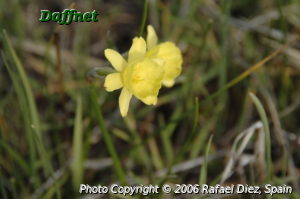
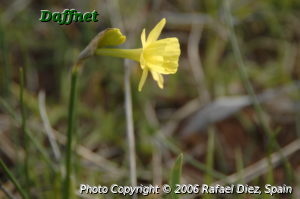
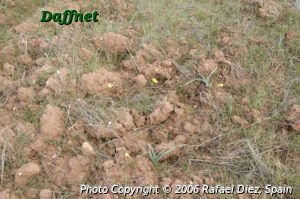


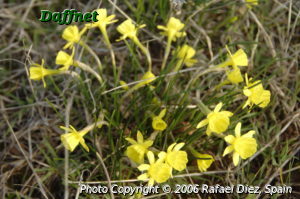
I took these pictures eight years ago, as you can see the field was covered by Narcissus vilchezii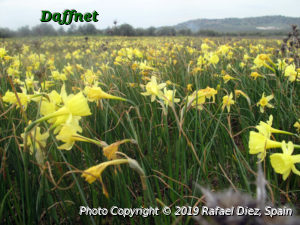
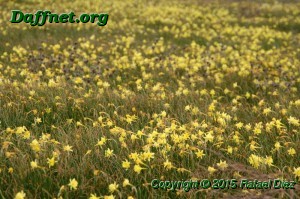
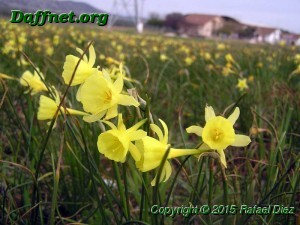
I took these pictures past February in the same place. As you can see there is a fenced land with some clumps en the middle, also a road and other remining clumps in de middle of training horse camp.
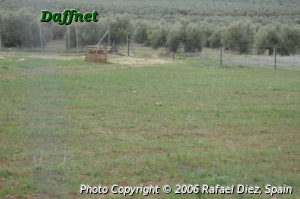
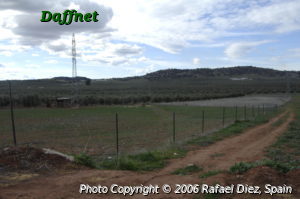

Not very far from this locality, a place with N. x tuckeri, just few plants between N. fernandesii, but any presence of N. blancoi in kilometers. The places where N. blancoi grew was an optimal soil to grow olive trees and this is why it has completely dissapeared. On the other hand N. fernandesii grows in heavy clay soil and is not good for olive trees so this land is not modyfied.
There are just two localities of Narcissus vilchezii (the fertile N. x tuckeri) the first one is in the village and is going to disappear soon. The another one, that Theo pictured time ago, seems to be very healthy.
Both localities share a common factor: they grow in heavy clay soil that is usually flooded and is not good for any agricultural work. These land have never been plowed (at least, in the past 60 years) because you can’t grow anything.
I collected seeds of other hybrids (N.x perez larae, N. x alleniae, N. x montielanus…) in clumps that I marked in blooming time. They have produced seeds but very few and I am not sure if
they really were F2 seeds as the hybrids lived with the parents.
In the case of Narcissus vilchezii, one of the parents has totally dissapeared and the other parent Narcissus fernandesii is almost extiguished by N. vilchezii, and there aren’t enough plants to create such a huge amount of hybrids. So how to explain such amount of plants (+30.000??) that are not F2, F3, F* and also they aren’t increased by ploughing.
I have read that Prof. Theo, did the pollen test and it was sterile, but in my field observations I found many seeds. I did a drawing about it (sorry if some text is cut, I haven’t a good scanner)
That you can see when you dig a clump of Narcissus vilchezii is two kind of bulb forming.
1. Vertically: Little bulbs all ages are growig arround the blooming bulbs and migrating from the surface to the correct depth.
2. Horizontally: Vegetative divisions are increaing the number of blooming size bulbs.
When you study any of the blooming size bulbs, you can find seeds from past years germinating and growing in different stages, into the external and papyraceus tunics.
The dry leaves and the rest of tunics acting as soild and when it is moist the seeds find the optimal conditions to germinate.
This way, each clump could have huddreds of bulbs all ages, very compacted by the heavy clay soil. In fact I think the very few seed production can’t germinate and penetrate in this soil and this is why the seeds can only germinate in the rest of its own clups reinforcing the amount of bulbs.
Also, not every year, not every clump produce seeds. I think it is a lottery, and the capsules are, like in other hybrids, not well formed with 1, 2, 3… seeds
Like in Narcissus grandae and Narcissus milagrosus, this is another case of a mysterious mecanism that creates a species from an hybrid that replace the ecological role of one or both parents.
Rafa,
Your observations are interesting and of great value.
For a species many seeds per capsule should be generated. Without this property it cannot proliferate and exist for a long time. I think it is high time to clarify the chromosome constitution of the new species N. grandae, N. miliagros, and N. vilchezii. Perhaps we have in our big family of daffodil enthusiasts anyone who can do this. Then we can decide whether it was correct to denominate these plants as species.
Theo
Theo,
I think we share a concern about these new species names – they may be fertile and ’in the process’ of becoming new species taking over the habitat of one of or both parents.
However, while parents still exist and hybrids occur that may or may not be fertile there is no way that we can separate or distinguish the original x hybrid (eg.N. x barrae from N. grandae or N. x tuckeri from N. vilchezii)
by simple observation (morphology). Would simple microscopic examination of the pollen help to distinguish – or must we go to Chromosome counting and DNA techniques? Maybe there are answers in the published
papers but my Spanish is much too limited.
I agree with you.
The case of N. grandae, is the only one that I consider as a 100% species. In fact it is the Bulbocodi that produce more seeds per capsule, even more than the gigant N. bulbocodium subsp. validus. So in this case, no mater if there are two or just one parent, N. grandae blooming before them and it produce its own seeds.
N. milagrosus and N. vilchezii are different, they have this precarious sexual reproduction, but the amout of plants are telling us that there is something more than only vegetative reproduction, as one of the parents has disappeared and the other one is almost extinct and is not capable to create such amount of plants based only in F*. Both cases could be ajusted to the concept of nomospecies (a species that is being forming from two species) similar to N. tortifolius, N. dubius, N. deficiens… (although not so avanced in these process) We can say that N. vilchezii and N. milagrosus just started as nomospecies and N. grandae has finish this porcess and it is a formal species as it can patent its own genetics by seeds that produce by itself, like N. dubius, N. tortifolius….
Other case of a begginer in nomospecies process would be Narcissus piifontianus, a N. x perez-larae that grows without its parents. Like N. x vilchezii, pollen test say sterile, but it produce seeds in the same way that I showed in my draw: very few, not every bulb and not every year.
Brian and Rafa,
For N. grandae because of the many seeds and the size of the pollen grains it is nearly sure that it is a new allotetraploid species. Nevertheless we need the chromosome constitution for validation.
T’heo
ok, Theo I hope someone can make this research.